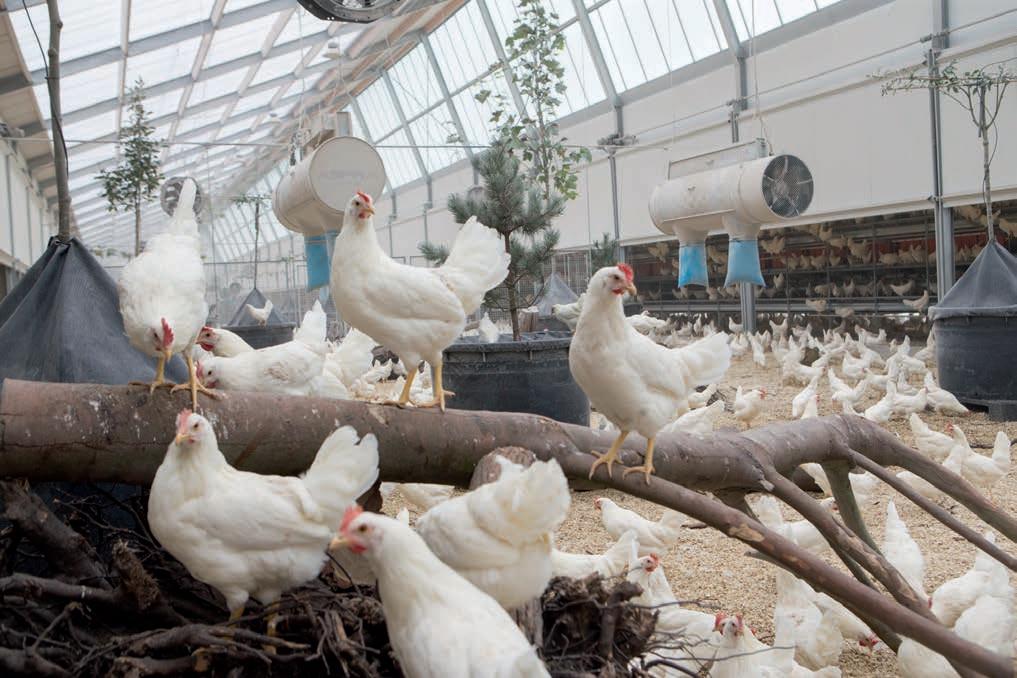
4 minute read
The right genetics & the right people
from PoultryNL
The right genetics
You might have heard the question about which came first, the chicken or the egg? But whether it is commercial dayold chicks, pullets, eggs sold in supermarkets, or even eggs used in the manufacture of vaccinations, the whole process starts with the breeding companies.
Advertisement
the right people&
Four times a week, Joice & Hill processes a set of up to 300,000 eggs that hatch 21 days later, meaning that at any one time at the company’s hatchery in Peterborough there can be over 2 million hatching eggs in incubation! But it is not just about sheer quantity. ‘We sell on three main factors’, explains Nick Bailey, the company’s Managing Director. ‘The fi rst is the strength of the breeding program behind the breeds we sell. From a genetic perspective, we off er strong, robust products that have the genetic potential to lay more fi rst-quality eggs compared to any other chicken breed available in the UK market. The chicken breeds of Hendrix Genetics have been clearly selected for persistency, allowing today’s egg producers to keep their fl ocks longer with every new generation that arrives at the farm. But it is also no secret that you can only get the best genetic potential out of the fl ock when the quality is good. That’s the second factor we are focusing on: good quality, healthy, viable, well-vaccinated chicks. The quality of laying hens that the egg producer gets is dependent on the quality of the chicks that the rearing farm gets from the hatchery. Finally, you need good management on the farms. That’s why our sales representatives have very technical backgrounds.’
Good staff is essential
‘Our staff is there to support rearing companies and egg producers with fl ock management, technical and nutritional advice. It really is of advantage to us that we can always ask for extra support from the head offi ce. By sharing best practices and knowledge from overseas countries they can off er new insights and management practices.’ ‘So people are essential, throughout our entire organisation, from parent stock farm to hatchery, from back-offi ce to technical service. One of the biggest challenges that we are facing today is fi nding good quality people at every level of the company. There is a huge shortage of good livestockoriented people in the UK, especially since Brexit. As the result of COVID-19, we’re starting to see interest from people wanting to be involved in food production and agriculture’, Nick Bailey points out. ‘To be honest, I think the sector has loads to off er, it’s a great career, you’re in the countryside, working with people and livestock in an innovative and dynamic sector that brings a superfood to the table!’
White egg breeds are more sustainable
Besides having the right staff , it is key to have the right breeds to meet the needs of the market. ‘There are risks in our business, but we won’t risk our clients’ success by sending them chicks that do not fulfi l our high quality standards or their demands. But as producing and hatching eggs is more expensive compared to producing a regular table egg, we must target 95% hatching egg utilisation.’
Nick Bailey, Managing Director of Joice & Hill: ‘We need to play a role in training a new generation of livestock workers and farmers.’

To achieve this level of success, Joice & Hill needs to know its customers and market well. ‘The parents we’re placing this month will still be in production towards the autumn of next year. We have to know now what we think we’re going to sell next year.’ This means Joice & Hill isn’t just watching trends, they are anticipating them. Despite the fact that the UK is a traditional brown egg market, Joice & Hill is investing in the Dekalb White, in the belief that the Dekalb White has to off er important advantages to the evolving UK egg sector. ‘White breeds are still more effi cient, and some like the Dekalb White are also very suited for cagefree egg production. They clearly show better livability, egg laying persistency, better livability, egg laying persistency, lower daily feed consumption and better lower daily feed consumption and better feather cover compared to any brown feather cover compared to any brown breed available in the UK. So, they off er breed available in the UK. So, they off er some real benefi ts in terms of sustainable some real benefi ts in terms of sustainable egg production, especially as the carbon egg production, especially as the carbon footprint of food becomes more important. footprint of food becomes more important. With White breeds, you get more eggs for With White breeds, you get more eggs for less feed and the product is not nutritionally less feed and the product is not nutritionally diff erent!’ diff erent!’
The future of Joice & Hill The future of Joice & Hill
When asking Nick Bailey about the future When asking Nick Bailey about the future of Joice & Hill, his mind immediately goes of Joice & Hill, his mind immediately goes to the companies’ responsibilities. ‘We to the companies’ responsibilities. ‘We
The sector has loads to off er
need to conduct our business and look after our animals in a way that meets the expectations of consumers and society. We need to supply the market with the right genetics and the right technical support. We need to feed back the needs of our market to keep the Hendrix Genetics R&D department aware of how their products are performing and what improvements are needed. But, most of all, we need to play a role in training a new generation of livestock workers and farmers.’










